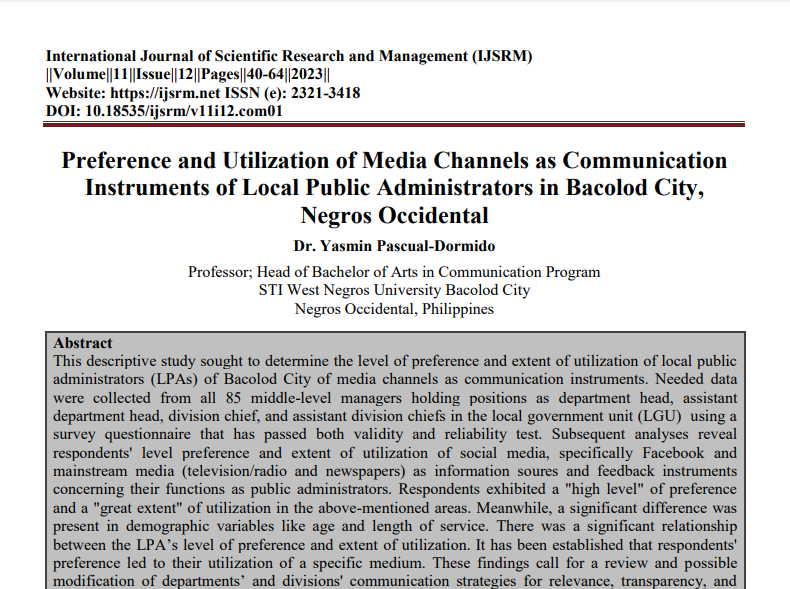Preference and Utilization of Media Channels as Communication Instruments of Local Public Administrators in Bacolod City, Negros Occidental

Submission to VIJ 2023-12-05
Keywords
- Mainstream/Social Media,
- Preference,
- Utilization,
- Local Public Administrators,
- Philippines
Copyright (c) 2023 Dr. Yasmin Pascual-Dormido

This work is licensed under a Creative Commons Attribution 4.0 International License.
Abstract
This descriptive study sought to determine the level of preference and extent of utilization of local public administrators (LPAs) of Bacolod City of media channels as communication instruments. Needed data were collected from all 85 middle-level managers holding positions as department head, assistant department head, division chief, and assistant division chiefs in the local government unit (LGU) using a survey questionnaire that has passed both validity and reliability test. Subsequent analyses reveal respondents' level preference and extent of utilization of social media, specifically Facebook and mainstream media (television/radio and newspapers) as information soures and feedback instruments concerning their functions as public administrators. Respondents exhibited a "high level" of preference and a "great extent" of utilization in the above-mentioned areas. Meanwhile, a significant difference was present in demographic variables like age and length of service. There was a significant relationship between the LPA’s level of preference and extent of utilization. It has been established that respondents' preference led to their utilization of a specific medium. These findings call for a review and possible modification of departments’ and divisions' communication strategies for relevance, transparency, and responsiveness.
References
- Ahmad, N., Lasfer, A. & Makhsoos, F. (2012). European, Mediterranean & Middle Eastern Conference on Information Systems, p 410, The Fashion Information Technology. Retrieved from https://scholar.google.com/scholar?q=related:sjoB-UJriAJ:scholar.google.com/&scioq=Spool,+2011+People+ad opt+these+technologies&hl=en&as_sdt=0,5
- Apique, C. D. R., Briones, C. G., Cabanday, A.R., Dela Pena, N, & Musni F.M. (2017). International Journal of Liberal Arts, Education, Social Sciences, and Philosophical Studies, 5 (1). Adoption of New Media Technologies: A Multi-Generational Comparison, 173-174, 186.
- Criado, J. I., Gil-Garcia, J. R. & Almazan, R. S (2013). Government Information Quarterly, 30 (4), article. Government Through Social Media. Retrieved from https://www.researchgate.net/publication/259131981_Gover nment_Innovation_Through_Social_Media
- Hall, B. & Khan, B. (2003). The National Bureau of Economic Research, New Economy Handbook, Paper No. 9730, p1. Adoption of New Technology Retrieved from https://www.nber.org/papers/w9730.
- Mahajan-Cusack, L., and Holzer, M. (2016). RUcore: Rutgers University Community Repository Vol. 4 p. 161. The Impact of Social Media on Local Government Transparency and Citizen Engagement. Retrieved from https://rucore.libraries.rutgers.edu/rutgers-lib/50539/
- Mickoleit, A. (2014). OECD Working Papers on Public Governance ISSN: 9934351 No. 26 p 3 Social Media Use by Governments: A Policy Primer to Discuss Trends, Identify Policy Opportunities, and Guide Decision Makers. Retrieved from https://www.ospi.es/export/sites/ospi/documents/documentos/Social_Media_use_by_Governments.pdf
- Mings, S. (1997). Uses and Gratifications of Online Newspapers: A Preliminary Study. The Electronic Journal of Communication, 7 (3), 1. Retrieved from http://www.cios.org/EJCPUBLIC/007/3/007312.
- Olsson, E. & Eriksson, M. (2016). Researchgate Publication: The logic of public organizations’ social media use: Toward a theory of ‘social mediatisation.’ Retrieved from https://www.researchgate.net/publication/304299745_The_logic_of_public_organizations%27_social_media_use_Toward_a_theory_of_%27social_mediatization%27
- Oyza, I. & Agwu E. (2015). Journal of Internet Banking and Commerce ISSN: 1204-5357 Effectiveness of Social Media Networks as a Strategic Tool for Organizational Marketing Management. Retrieved from http://www.icommercecentral.com/openaccess/effectiveness-of-social-media-networks-as-astrategic-tool-for-organizational-marketingmanagement.php?aid=66382
- Roengtam, S., Nurmandi, A., Almarez, D.& Kholid, A. (2017). "Does social media transform city government? A case study of three ASEAN cities: Bandung, Indonesia, Iligan, Philippines and Pukhet, Thailand", Transforming Government: People, Process and Policy, Vol. 11 No. 3, pp. 343-376. Retrieved from https://doi.org/10.1108/TG-10-2016-0071
- Song, C. & Lee, J. (YEAR). Public Performance & Management Review Volume 39, 2016 - Issue 2, p. 1. Citizens’ Use of Social Media in Government, Perceived Transparency, and Trust in Government. Retrieved from https://www.tandfonline.com/doi/abs/10.1080/15309576.2015.1108798.
- Tkatchova, S. (2013). Bartleby Research p. 5. Analyzing Mankin's Theory of Utilization of Resources. Retrieved from https://www.bartleby.com/essay/Analyzing-Mankins-Theoryof-Utilization-of-Resources-P3KZ8FPMZRFS
- Bianca, A. (2017). Career Trend: Importance of Communication in Public Administration p 1 https://careertrend.com/importance-of-communication-inpublic-administration-13657534.html
- Bruton, J., Bruton, L., & Lumen Learning Lumen Learning: Module 14 p 1. Channels of Business Communication. Retrieved from https://courses.lumenlearning.com/wmprinciplesofmanagement/chapter/channels-of-businesscommunication/
- Mass Media Preferences Among Students: A Study of IMT Students, Enugu. https://www.grossarchive.com/upload/1415883417.htm